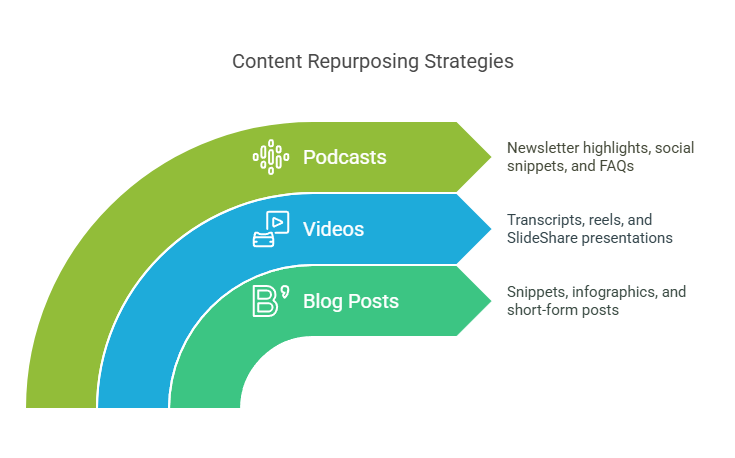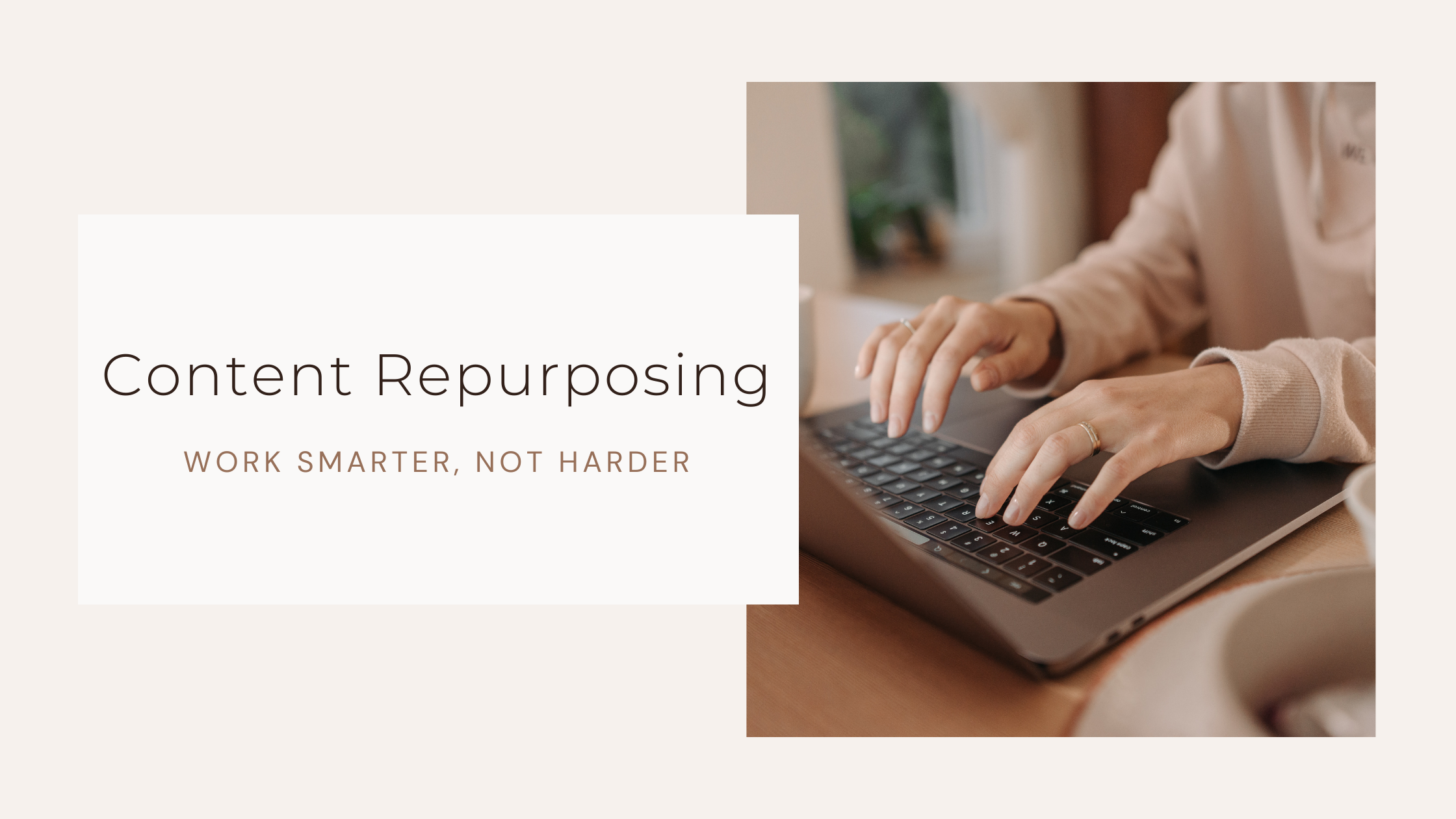Let’s get one thing straight: creating consistent content is hard work. Whether you’re a mental health professional or a social justice warrior, chances are you’ve spent hours (or days) crafting a piece of content that speaks to your audience. And then, what? You hit “publish,” share it a few times on social media, and… hope for the best?
There’s a better way.
Enter content repurposing—the magical process of squeezing every last drop of value out of your work. Think of it like turning leftovers into a gourmet meal. The other day I made chicken for dinner. The next day I turned the leftover chicken into a stir fry. Then, I used the leftover rice to make chicken and vegetable fried rice the next. I saved time and money because I wasn’t reinventing a new meal from scratch each time.
Repurposing your content is no different. It saves time, stretches resources, and helps your message reach new audiences. In this blog, we’re going to show you how to breathe new life into your content.
Get ready to work smarter, not harder.
What Is Content Repurposing (and Why Should You Care)?
Content repurposing is like giving your content a second (or third) act. Instead of creating brand-new pieces from scratch every time, you adapt your existing content into different formats for different platforms.
Not only does this save you time (because seriously, who has the bandwidth for constant content creation?), but it also:
- Boosts your visibility on social media, blogs, email campaigns, and YouTube.
- Improves your SEO by expanding the reach of your keywords.
- Helps you connect with new audiences who prefer a variety of content formats.
For professionals in mental health and social justice, this isn’t just about marketing; it’s about amplifying your voice and mission.
From One Piece of Content to a Whole Library

Here’s the secret: every piece of content you create has the potential to become 5–10 more. Here’s how:
1. Transform Blogs into Social Media Gold
Got a killer blog post breaking down therapy misconceptions or debunking myths about systemic racism? Let’s rework it.
- Snippets for social media: Pull key quotes and stats to create LinkedIn posts or carousel slides for Instagram.
- Infographics: Visual content gets noticed. Turn your blog’s takeaways into an infographic for easy sharing.
- Short-form posts: Summarize your blog into a punchy caption for Twitter or a quick video for TikTok.
Stretch Videos into Infinite Possibilities
Your YouTube video on trauma-informed care or the impact of food deserts shouldn’t just live on YouTube.
- Transcripts: Turn the transcript into a long-form blog post.
- Reels and TikToks: Chop the video into 15-second snippets for Instagram Reels or TikTok.
- Slideshare: Use key screenshots to create a professional SlideShare presentation for LinkedIn.
Podcasts That Keep on Giving
If you’re recording a podcast, you’re sitting on a treasure trove of content.
- Newsletter highlights: Share the top 3 takeaways from each episode in your email marketing.
- Social snippets: Create audiograms (those cool audio clips with captions) for Twitter or Instagram.
- FAQs: Use the insights from your episodes to build a FAQ section on your website.
Advanced Moves: Going Big with Repurposing
Email Campaigns and Webinars
Take your content to the inbox and the stage:
- Email workflows: Create email series from your content. For example, a blog on self-care can evolve into a week-long self-care email challenge.
- Webinars: Turn a blog post or video into a live webinar, complete with Q&A.
White Papers and Case Studies
If your content dives deep, consider adapting it into professional resources.
- Case studies: Highlight success stories or interventions in a detailed format.
- White papers: Convert several of your research-backed blogs about connected topics into downloadable PDFs.
Leveraging AI and Automation for Content Repurposing
This can all seem very intimidating. You spent a lot of time creating a piece of long form content and now you are being expected to spend more time working on it.
Thankfully, content repurposing doesn’t have to be a manual process. There are countless AI and automation tools that can help you maximize your content’s reach with minimal effort. Here’s how:
- AI-Powered Summaries: Tools like ChatGPT can generate quick summaries of your blogs for social media captions, email teasers, or LinkedIn posts.
- Transcription for Repurposing: Services like Otter.ai and Descript can turn your videos and podcasts into text for blog posts, show notes, or newsletters.
- Visual Content Creation: Canva’s AI tools can transform blog content into infographics or short videos.
- Automated Social Sharing: Tools like Buffer and Missinglettr can auto-generate and schedule repurposed content across multiple platforms.
Scaling your content marketing can be done without significantly adding to your workload. Work smarter, not harder by using AI.
Measuring Success: Does This Actually Work?
Yes, but only if you track it. Keep an eye on your metrics:
- Are your repurposed social media posts driving traffic back to your website?
- Did your newsletter open rates improve with new snippets?
- Is your content ranking better on search engines?
Tools like Google Analytics and insights from LinkedIn or Instagram can help you fine-tune your content strategy.
Why It Matters for Mental Health and Social Justice Pros
Here’s the deal: your voice matters, but it’s competing with endless noise online. Getting attention is the hardest (and most important) piece of the marketing puzzle. Repurposing helps you cut through that noise. It ensures your message—whether it’s about destigmatizing mental health or advocating for equity—reaches the people who need it.
Plus, by working smarter with content repurposing, you free up time to focus on your real mission. (And maybe even squeeze in a little self-care, because you deserve it.)
Repurposing as a Springboard for New Content
One of the hidden benefits of content repurposing is how it can spark ideas for creating new content. Repurposing isn’t just about breathing life into your old blog posts or high-performing video content; it’s also about identifying gaps in your content marketing strategy and creating fresh pieces that align with your goals.
Using Repurposing to Identify New Opportunities
When you start adapting existing content, you’ll often uncover topics your target audience is hungry for. For instance:
- While turning a blog post into a podcast episode, you might discover unanswered questions your readers are asking. Voilà—your next blog topic!
- Analyzing engagement on social media platforms could reveal an interest in more in-depth tutorials or high-quality content on a related subject.
- Repurposing evergreen content often highlights trends or updates that deserve a new format, like an infographic or an interactive tool.
Repurposing isn’t just recycling; it’s a springboard for content creation that’s more informed and strategic.
Aligning New Content with Conversions
The ultimate goal of any digital marketing strategy is to drive conversions, whether that means growing your email list, booking consultations, or increasing donations. Here’s how repurposing supports this:
- Landing Pages: When creating new content, ensure it aligns with specific actions. For example, repurpose a guest post into a downloadable checklist that lives on a dedicated landing page optimized for conversions.
- Templates and Tutorials: Build trust by creating templates or step-by-step tutorials based on your existing content. This helps guide your audience toward the next step in their journey.
- Social Media Content: Short-form content (like TikToks or LinkedIn posts) can drive traffic to more substantial pieces like white papers or webinars, increasing the likelihood of conversions.
Experimenting with Different Types of Content
Repurposing gives you a safe space to test new types of content without starting from scratch. For instance:
- If a blog performs well, consider turning it into video content for YouTube or a series of bite-sized social media posts for Instagram.
- A podcast transcript could become an in-depth blog post, while the key points can fuel discussion in a guest post or LinkedIn article.
- Social media channels are perfect for experimenting with new formats like carousels, reels, or even interactive polls.
- Any written how-to content can be quickly turned into a workbook or guide highlighting your expertise and unique approach.
Takeaways: Your Content Repurposing To-Do List
- Start small: Pick one high-performing piece of content to repurpose.
- Experiment with formats: Try infographics, carousels, or podcasts.
- Track results: Use analytics to see what resonates.
- Repeat: Keep refining your content marketing strategy based on what works.
At Connected Ghostwriting, LLC, we’re here to help you tell your story and maximize your impact. We teach clients to repurpose the content we create for them so they save time and money. So, what are you waiting for? Dig into your archives, and let’s give your old content a new life.
Your mission deserves it.


